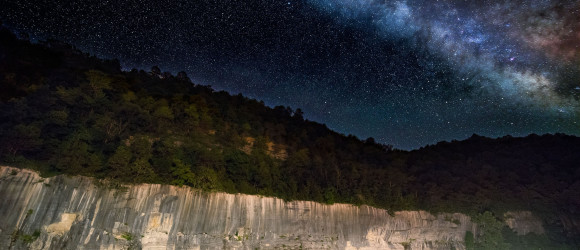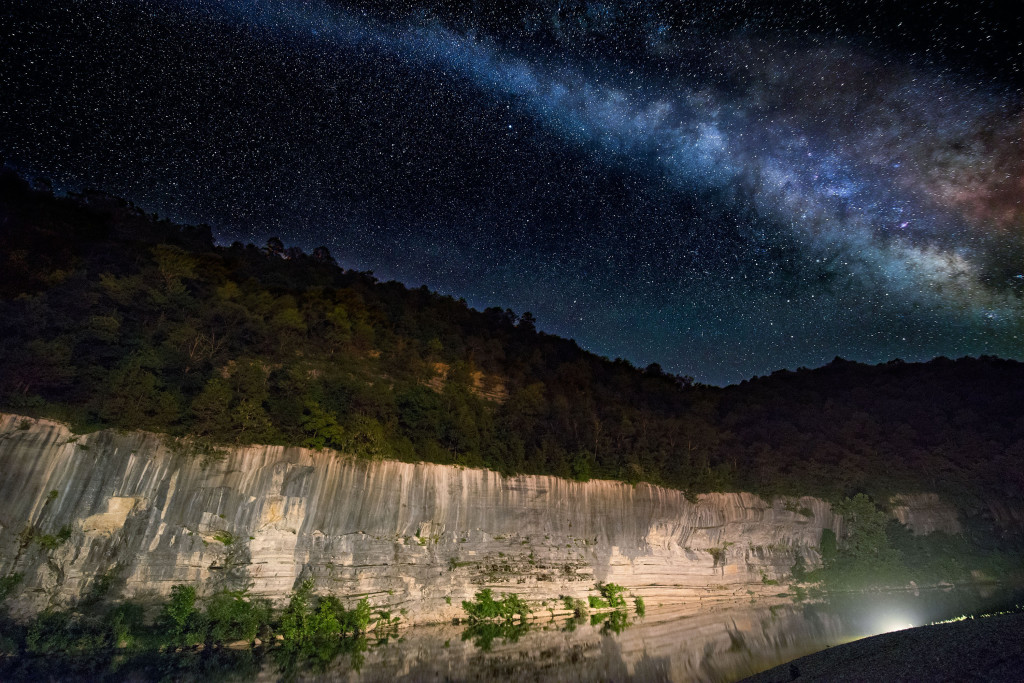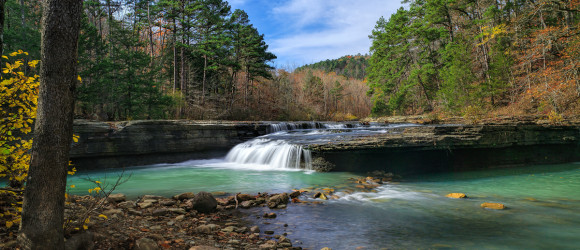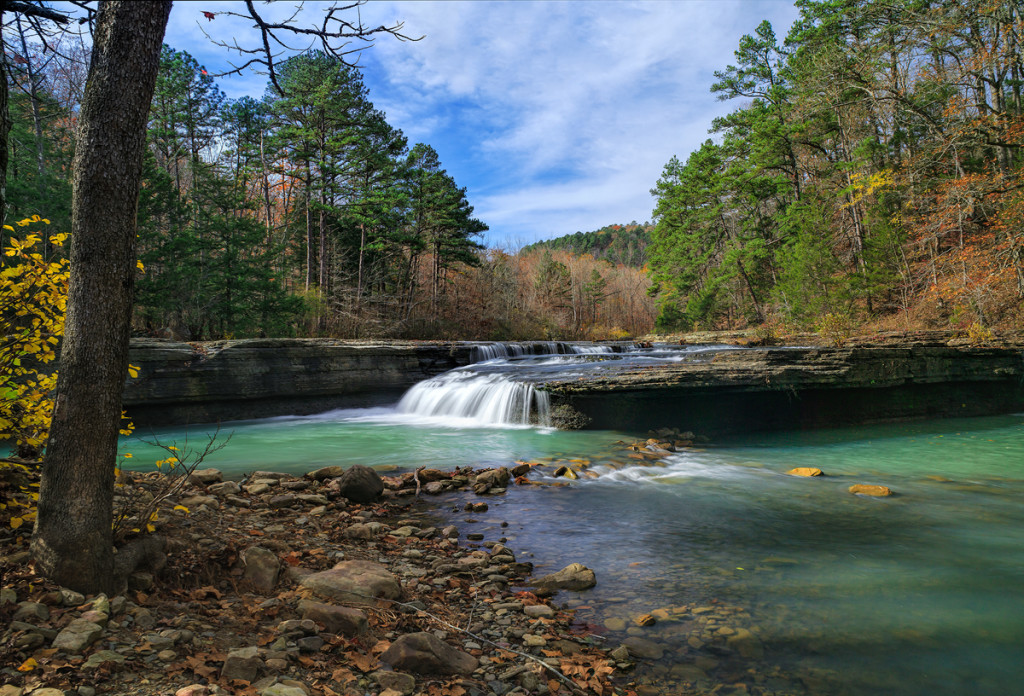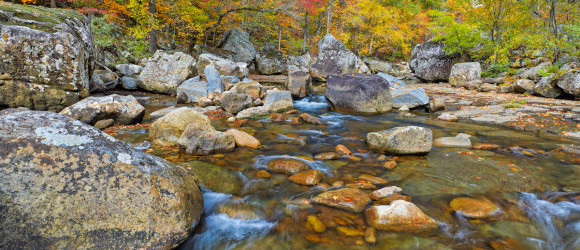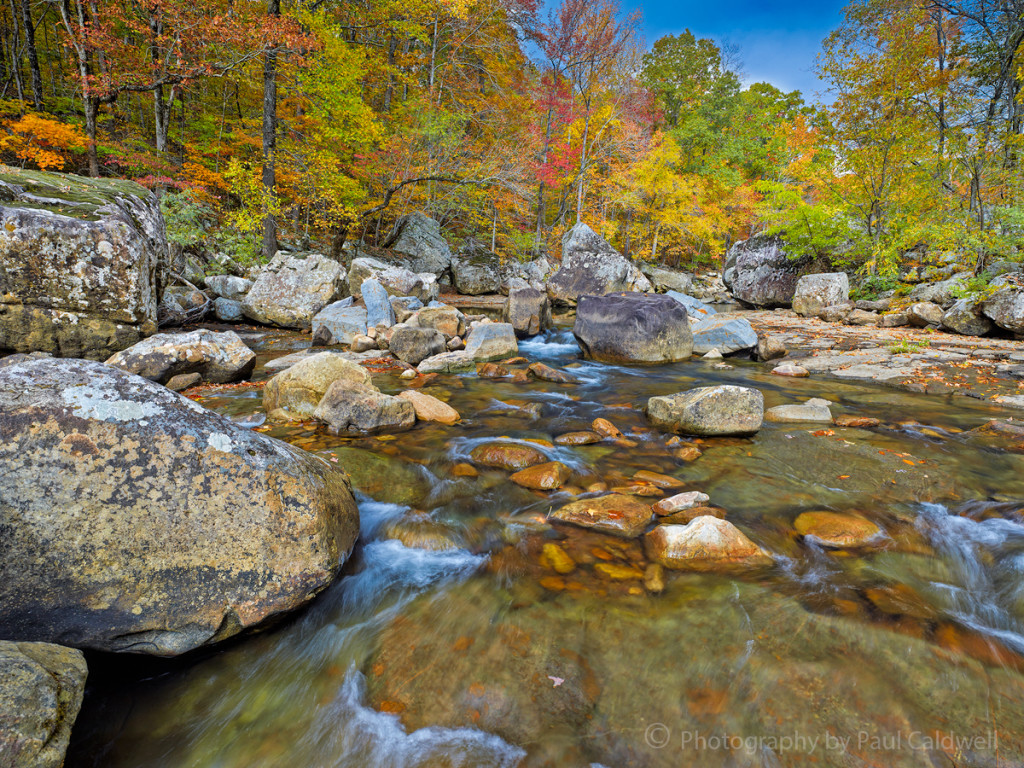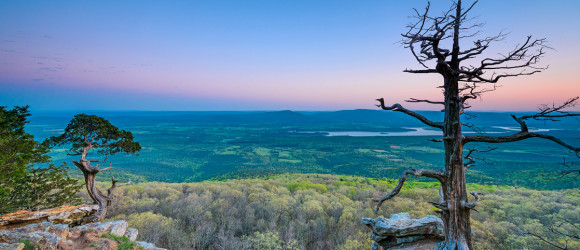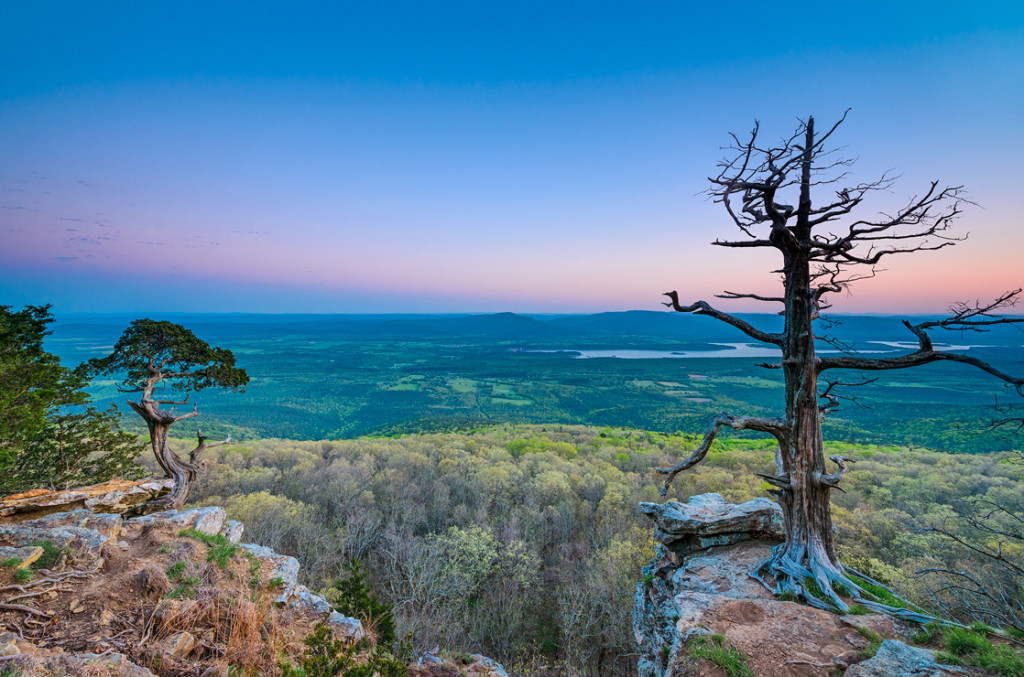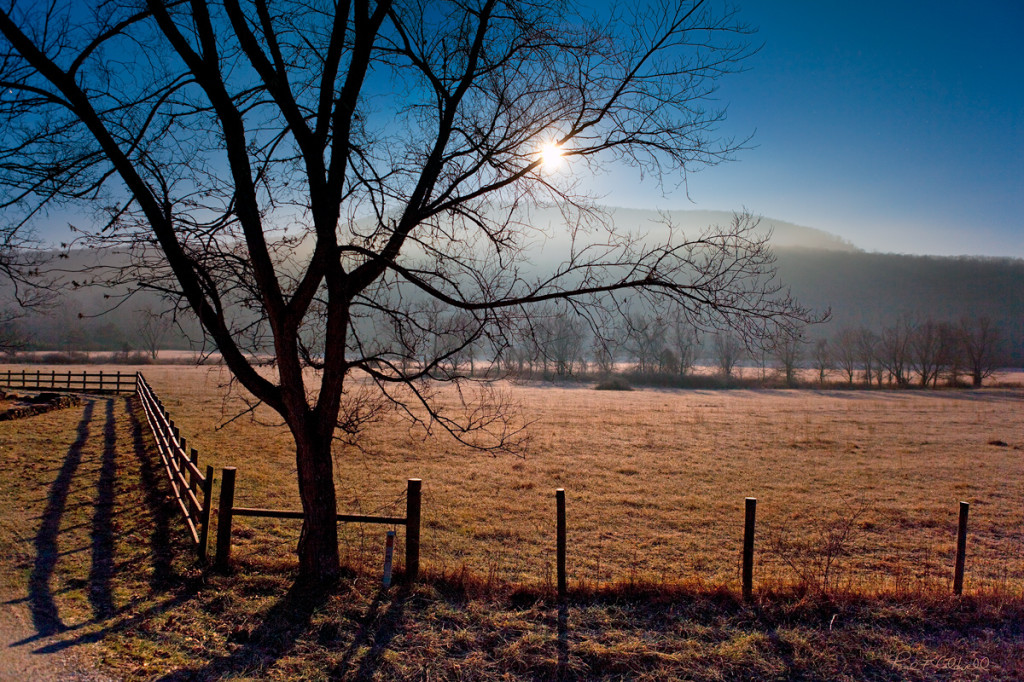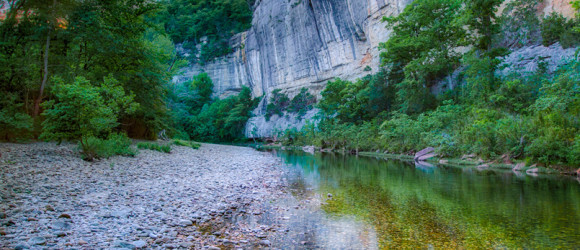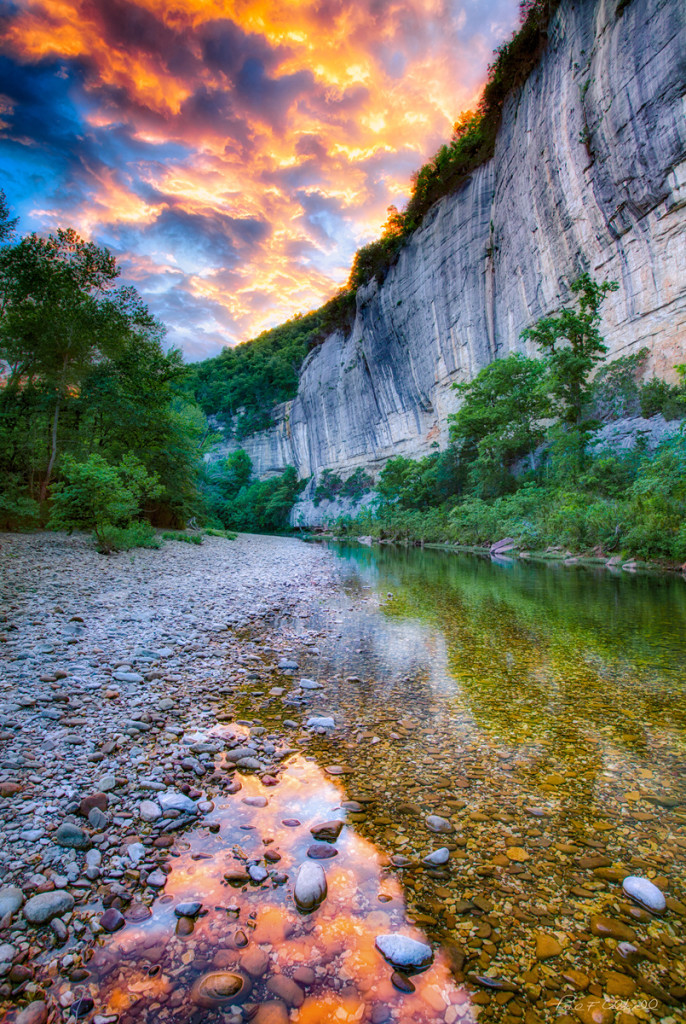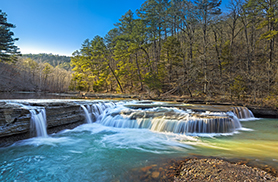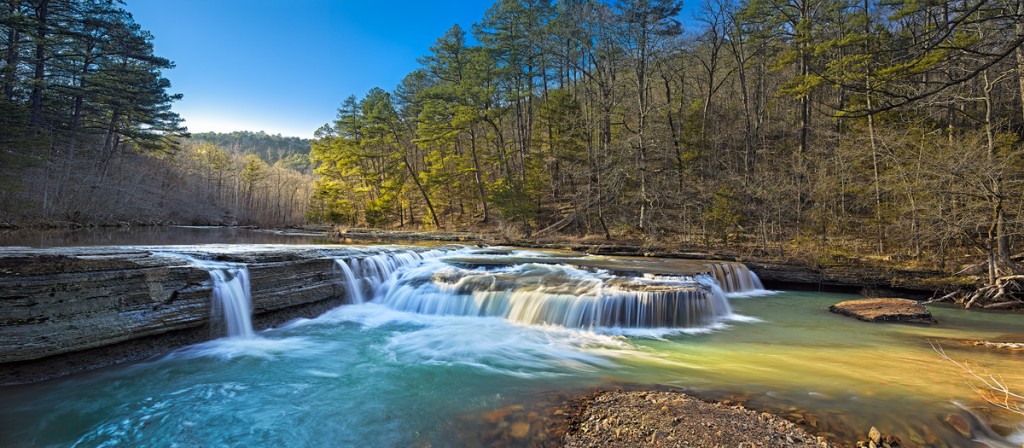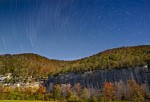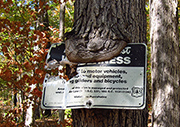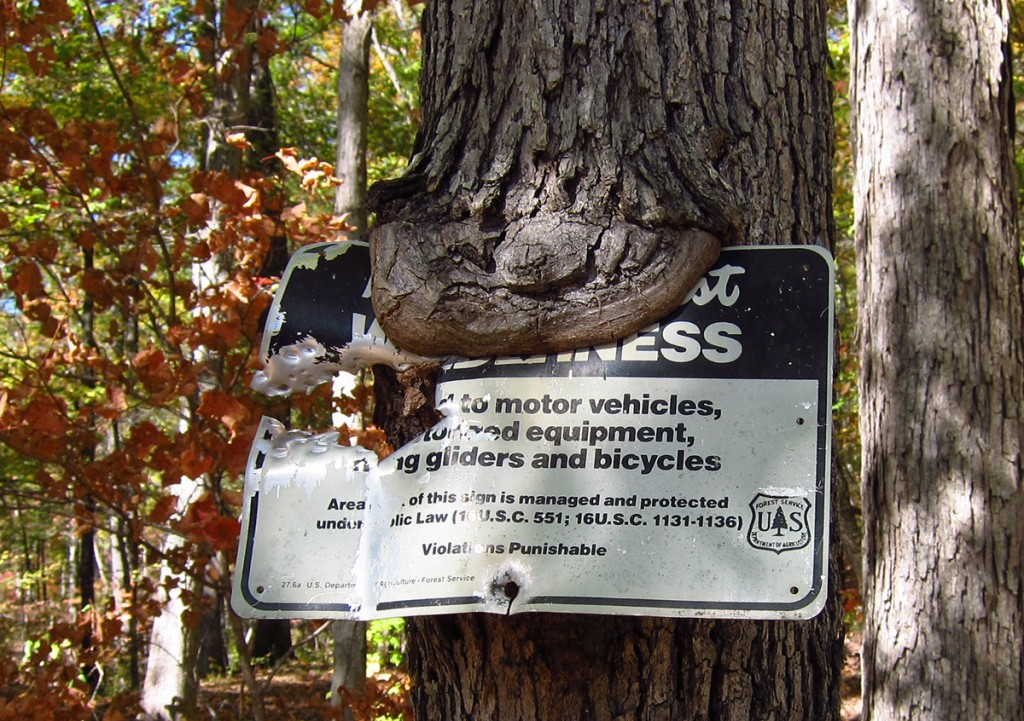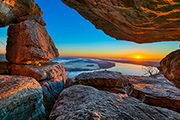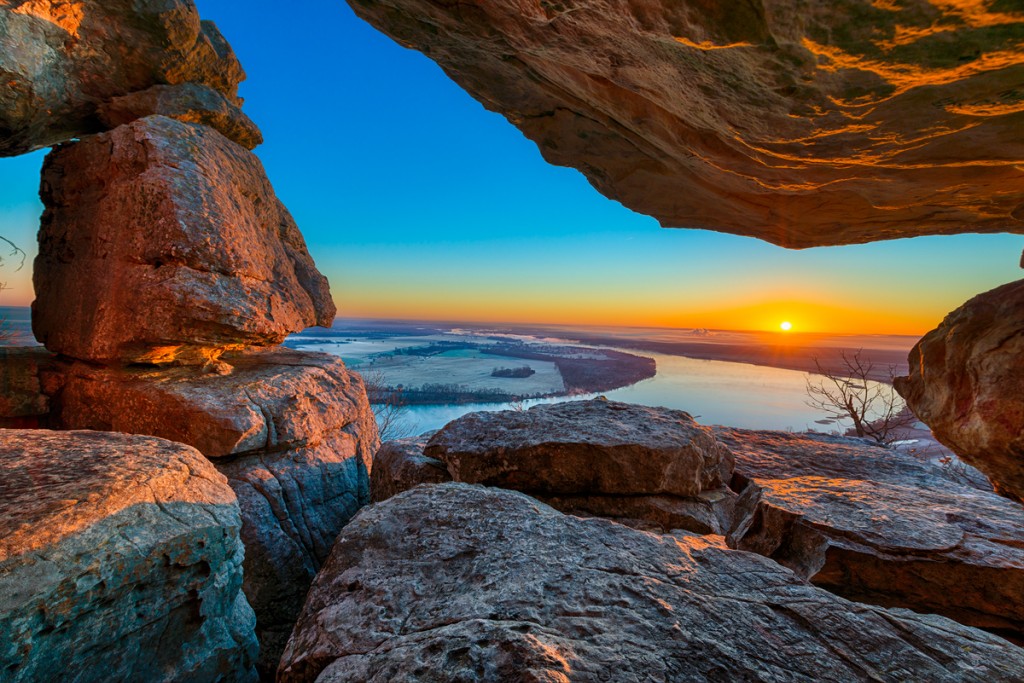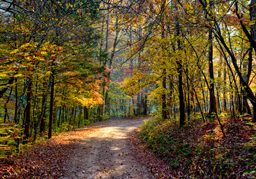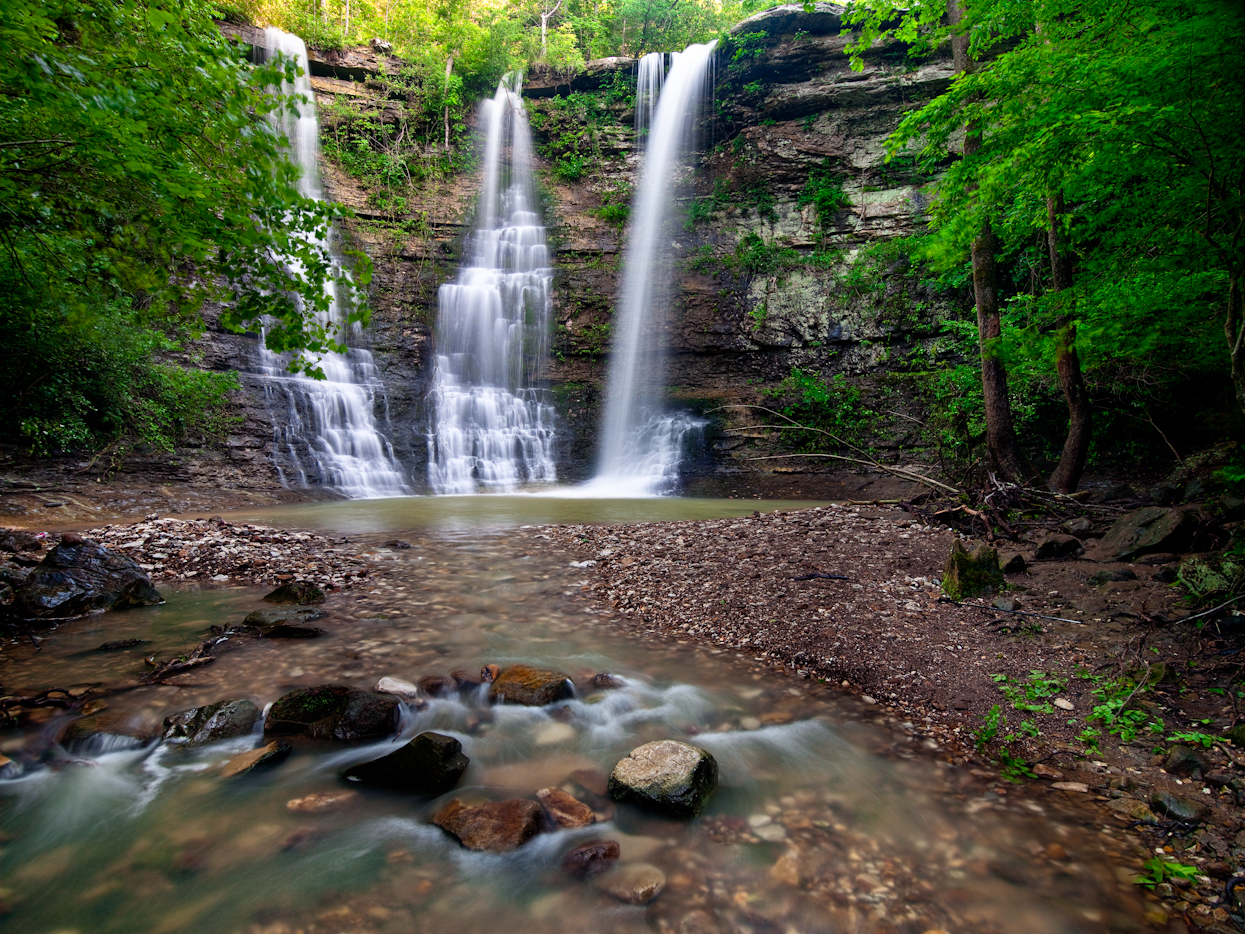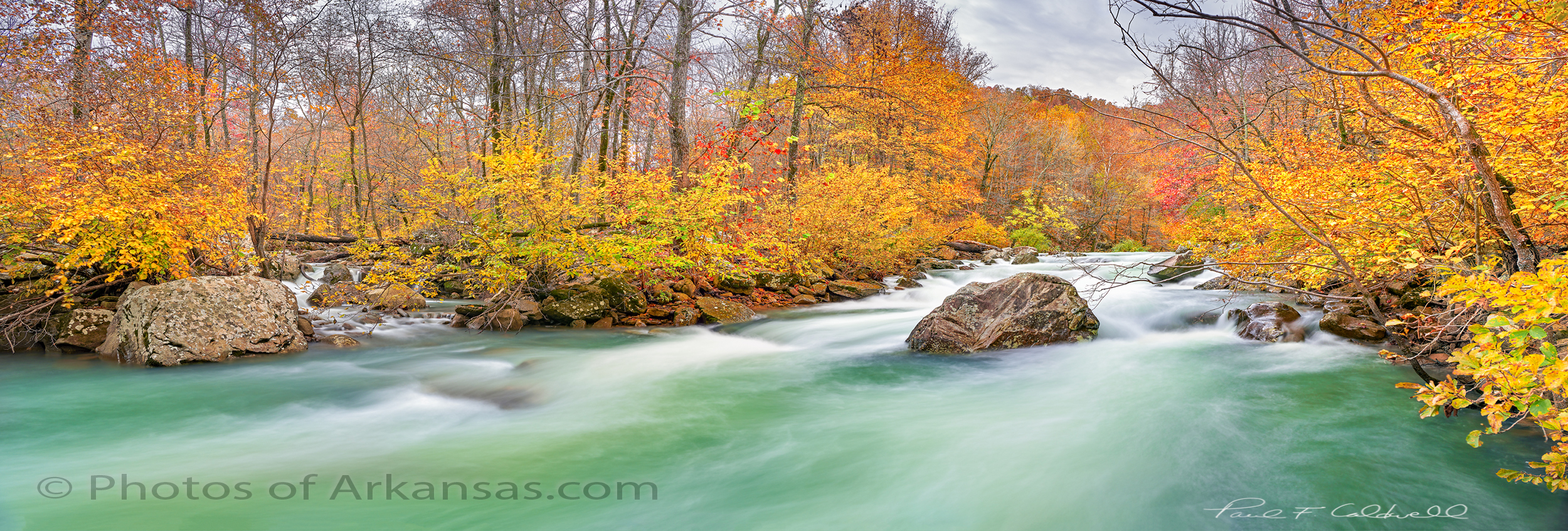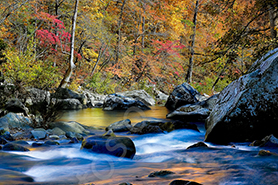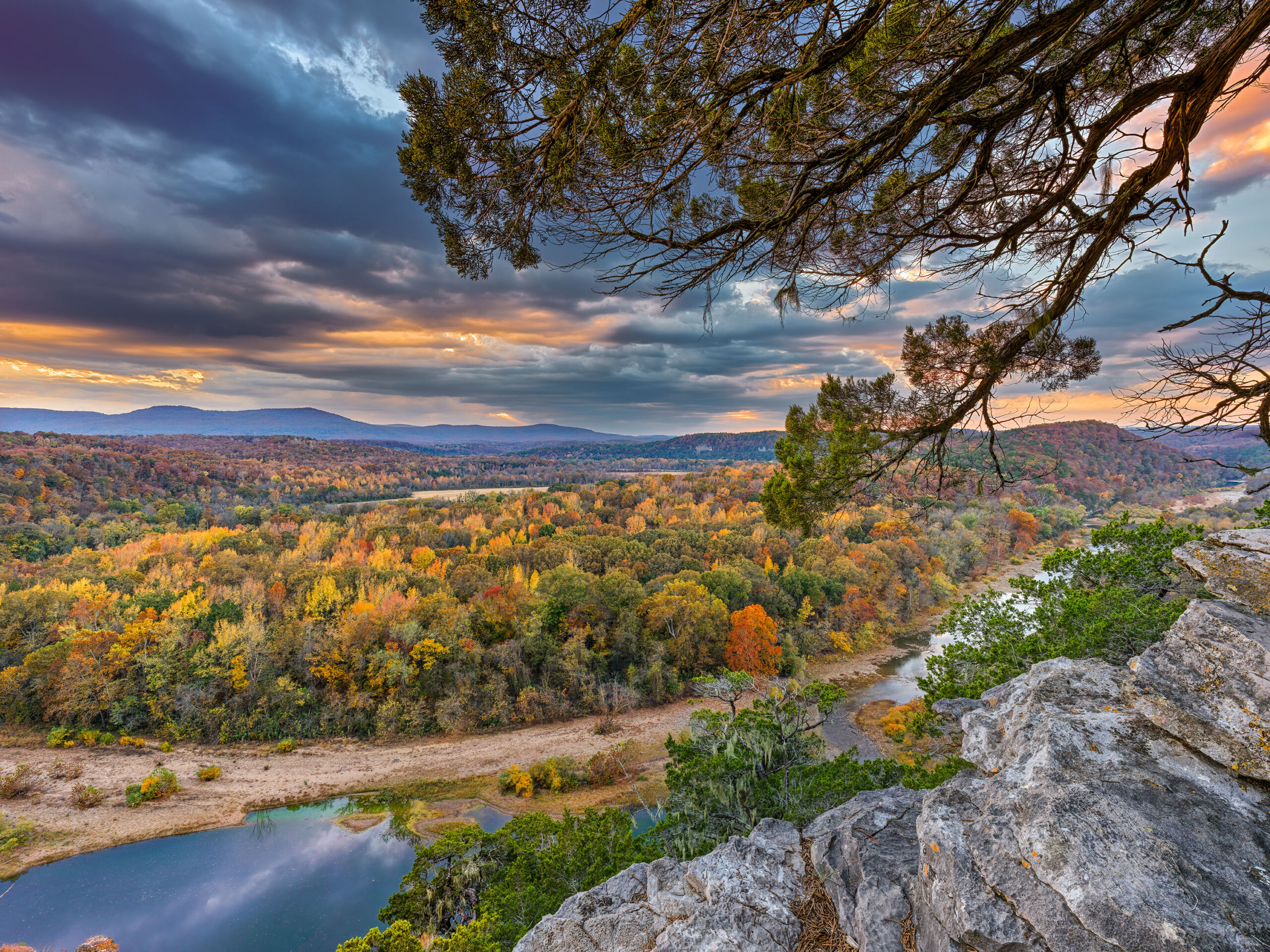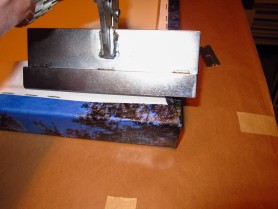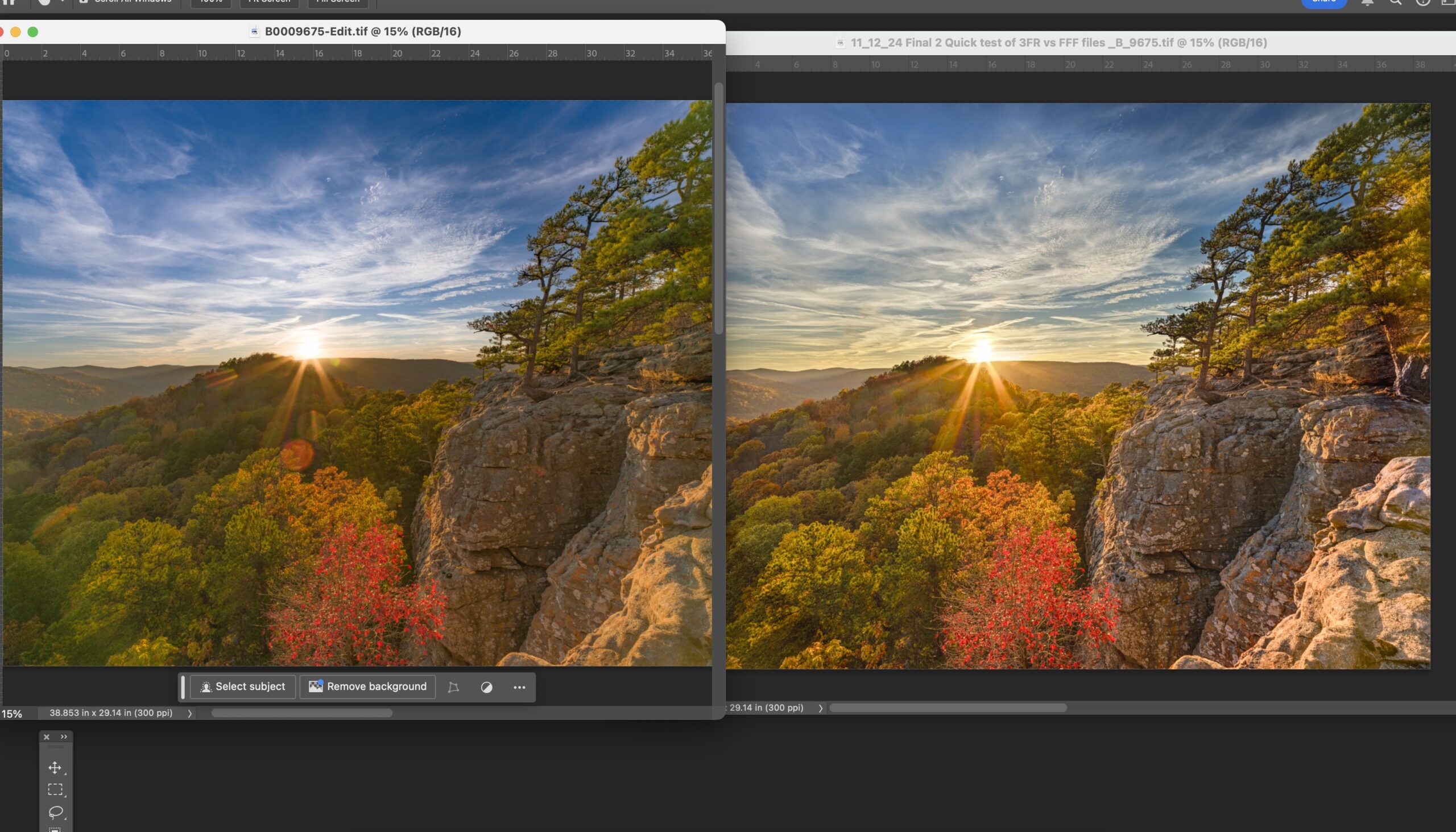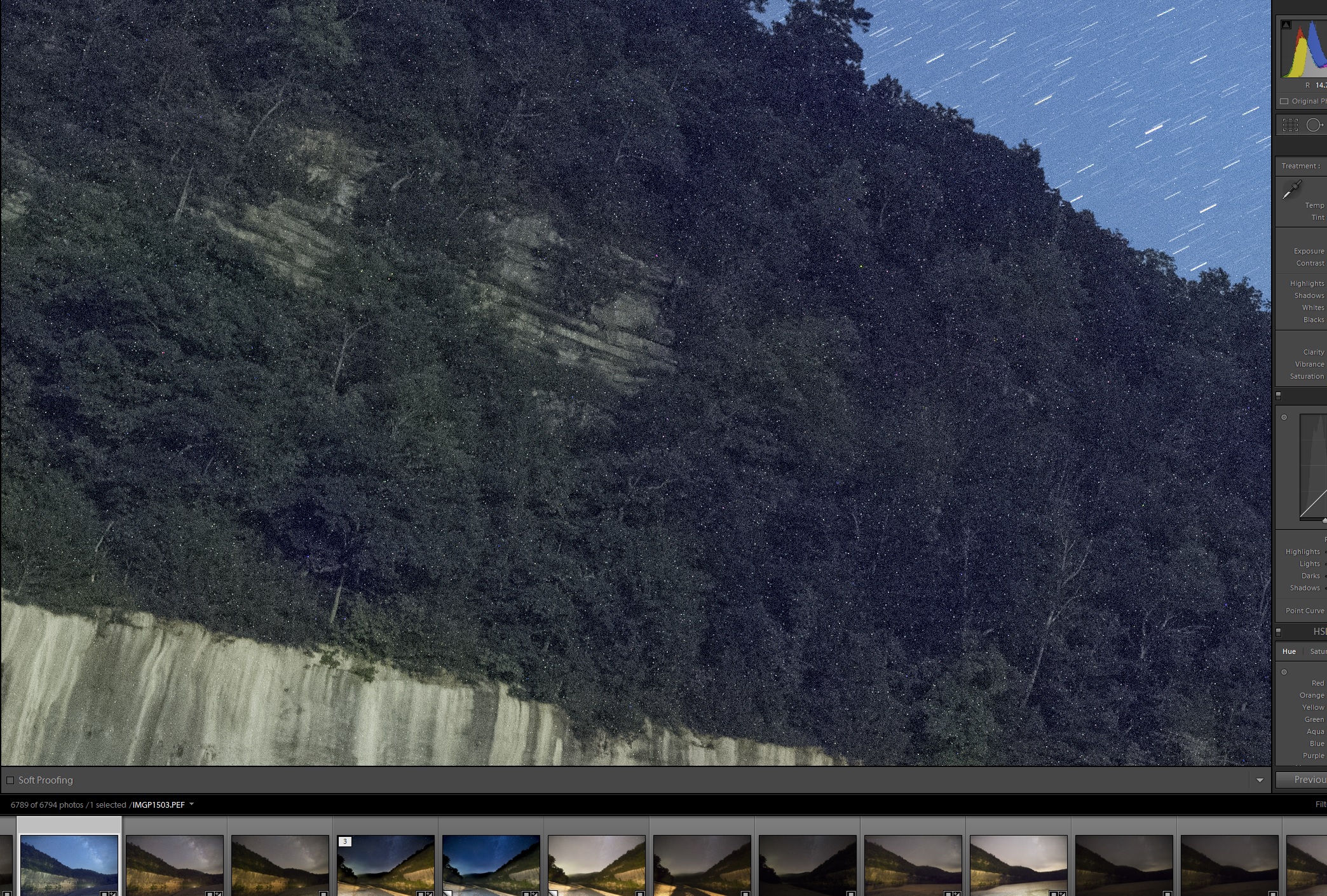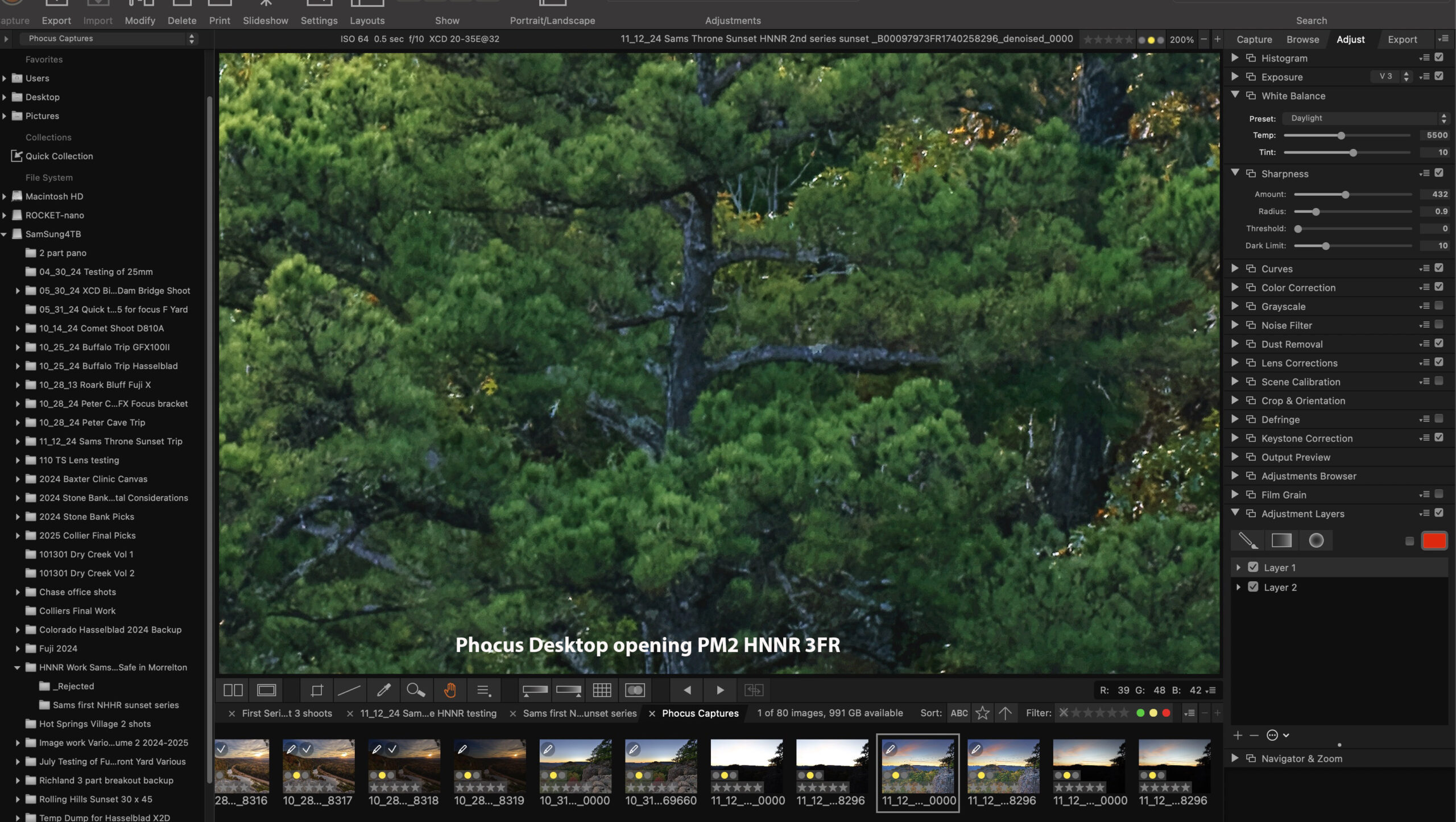08/08/16 Featured Arkansas Landscape Photography–Milky Way over Buffalo Point, Buffalo National River
Taken with a Pentax K1 and 15-30mm lens @ 15mm and F 3.2 ISO 3200 for 2 minutes using the Pentax Astrotracer function in camera.
This was my first test for night photography with the Pentax K1, and overall I was pleased with the results from the Astrotracer feature in camera. This photograph is a combo from a 2 minute Astrotracer shot for the MilkyWay, and several different shots for the foreground at various times. I used a small lantern down by the bluff to add some local illumination.
Chris Kennedy and I worked for about 2 hours, starting with a very clear night sky and temperatures around 89 degrees with 100% humidity. 2 hours later the temperature was about the same, so I was sweating just standing around waiting on the camera. But there was little to no wind so I was able to pull a nice reflection of the bluff on the river and if there had been a bit more water or a better angle by me, I might have gotten a Milky Way reflection.
Buffalo Point is one of the more popular spots on the Buffalo River, and the only campground with full electric hookups, so it will always be crowded in the summer months. You can either reserve a campground in the lower camping loops or you can try to get a spot in loop A, where it is always first come first serve, and loop A is the original WPA worked sites. I hope to get back to work this place in fall, both for the Milky Way and later on for Star trails. Star Trails will be a bit more difficult due to the location of the moon and due north.
Paul Caldwell
11/12/15 Featured Arkansas Landscape Photography–Haw Creek falls in Autumn
Taken with a Canon 1ds MkI, and and Canon 24-70 lens, iso 200.
I had to dig back a few years to find this, as it goes back to 2004, but since Arkansas had such a terrible fall in 2015 I have found myself doing this a lot lately. Haw Creek has some wonderful fall color displays but catching the falls with water in them and fall colors is one of the harder things to do. On the afternoon I caught this shot, I have been driving around looking for late fall color, stopping at both Falling Water Falls, and Richland Creek, but neither of them had much water. For some reason the rain that fell the night before did hit the Haw Creek drainage harder and the falls were running. I almost did not make the driver over from Lurton on Hwy 7, but was glad I did.
I was able to setup and get this shot before the sun moved over to the lower left of the frame. As it was the sun was perfect hitting on both the falls and the pool below. Note the green color, which is common to all Arkansas Ozark streams, but seems to be more prominent in the fall and winter. I have always assumed it’s due to the limestone content in the water.
I shot this photograph in 3 separate segments as I was wanting to get more overall resolution. The older Canon 1ds MKI only had 11MP and that’s just not enough for a large print. Now that Lightroom has added a stitching solution, I am going back to a lot my older Canon work, either from the 1ds or 1ds MKII as both cameras captured great color, but I was using either a totally manual stitching method or a Zork adapter. Using Lightroom’s new solution makes for a much faster stitching process and you are left with a dng file. This allows you still use Lightroom’s excellent tools on the image as if it was a raw file.
This year, the colors were terrible at Haw Creek, mainly brown. The water level was actually pretty good for a few day’s and I ran into a few photographers up there, but I didn’t even get my camera out. The trees just didn’t have any life to them.
Early fall morning along Richland Creek–05/29/15 Featured Arkansas Landscape Photography
- At May 29, 2015
- By paul
- In Featured Arkansas Photography
 0
0
Taken with a Phase One IQ160 and Arca rm3di camera and Rodenstock 28mm lens @ iso 50 for 1/2 second exposure.
I am a huge fan of Richland Creek, having spent at least the last 20 years or so exploring it’s vast reaches. I was lucky enough to Kayak this creek for over 10 years as that one of the best ways to get to know a creek. Richland (the name comes from the fact that the mouth of Richland near Woolum Ford on the Buffalo was excellent farming land) has some beautiful features throughout it’s length as it moves towards the Buffalo, but by far the best scenery is found in the 5 miles of the creek above Richland campground. This shot was taken on a fall morning and the sun was popping back and forth between the clouds. I was setup and waited on the best light for at least 20 minutes and only got about 2 minutes before the next bank of clouds rolled in. The level of water in the creek on this day was low but in many respects this is an excellent level for photography as you can safely stand in the middle of the creek for the best vantage points. One aspect of creek photography, if you don’t plan on getting wet, don’t bother.
This spot is directly below one of the larger rapids on Richland called, Shaw’s Folly. In this shot, look for the large rock on the upper right which is about the size of a small house. This marks the end of the rapid and all of the creek in the picture is just the run out. But in this shot you can see why I love Richland as it’s just full of huge rocks and each one has it’s own unique shape and color. The water was gin clear this day so I was able to feature some of the bottom of the creek by using a polarizer to cut the glare.
Springtime sunset from Mt Magazine–03/23/15 Featured Arkansas Landscape Photography
- At March 23, 2015
- By paul
- In Featured Arkansas Photography
 0
0
Taken with a Nikon D800e, single exposure with 0.9 ND grad filter on a Nikon 14-24 lens, F7.1 for 1/6 of a sec @ iso 320. The views from Mt. Magazine are some of the best vistas in Arkansas. The valley to the south, which is featured here looks towards Blue Mountain and below it, Blue Mountain lake. It’s easy to see where the timber industry has harvested all the natural hardwoods, below the Mt. Magazine as the deciduous trees run down the mountain to the park boundary. Springtime is a special time in Arkansas, I like to call the power puff period as all the trees will have different shades of green for about 2 weeks. After that, all the leaves will take on a similar dark green hue until fall.
This shot features the most famous tree on Mt Magazine, the bonsai shaped juniper. I would have loved to make it up to this spot when the huge dead cedar was still alive as it is a huge tree. It’s interesting still standing there and when you look at the roots, you have to wonder how it managed to live as long as it did as the vast majority of them are above the ground on the rock. Mt Magazine is the tallest spot in Arkansas at around 2,700 feet high.
Moonset in Boxley Valley on the Buffalo National River–02/18/15 Featured Arkansas Photography
Taken with a Canon 5D MK2, Canon 24-70 lens at F5.6, iso 400 for 40 seconds.
This photograph was taken in early January 2009, back in the good old days for me at least, (if you know me well, you know what happened in February of 2009). I was on a trip to photograph Elk in the Boxley Valley and this was my first field use of my new Canon 5D MK2. Before I purchased the Canon 5D MK2, I had been using my older Canon 1ds MKII, which just did not have a very good higher iso range. On this morning, I came around the last bend of Hwy 21 as it drops down into the western end of the Boxley Valley and saw this view of the moon setting over one of the larger mountains that surround the valley. What caught my eye was how the shadows played with the fence row in the foreground. The old oak tree provided a nice touch also as I framed the shot between the branches. You can see just a very light layer of clouds or fog that was starting to rise up over the mountain in the background.
When you view this photograph up close, you can also see all the frozen dew drops on the grasses and fence posts. If you have never taken a trip to the Boxley Valley, which is on the western headwaters end of the Buffalo National River, it’s well worth the time.
10/14/14 Featured Arkansas Landscape Photography–Sunset at Roark Bluff on the Buffalo River
Taken with a Canon 5D MKII, Canon 14mm F 2.8 lens, in a bracketed series of exposures @ iso 200 This one is a special shot as it was one of those photographs that was just pure luck. I was up on the Buffalo River with Bob Shull, mainly to work the night skies, and we were just up on the river setting up our cameras. I had been looking downstream as the moon was starting to rise and it was in a very nice position. I had left my Canon 5D MKII setup for a upstream shot of Roark bluff for later that night. The evening skies had been cloudless, so I was not very interested in a sunset. I remember for some reason I looked around, probably due to a noise on the river, and wow, all of a sudden a bank of clouds had rolled at just the right time and they were on fire! I had to shoot the 5D MKII in a series of bracketed exposures as I knew that I would not be able to pull in the entire exposure with just one frame. This scene only lasted about 6 minutes and then the sun dropped below the bluff. My first series, missed the reflections of the sunset on the water at my feet. The river was not dead calm, but I still was able to pull in the reflection of the sunset on the water and the river rocks.
This was one of those once in a life time lucky lighting shots, that unless you happen to live on the river and can be out there everyday, just doesn’t happen very often. This was one of the last major photographs I took with the Canon, as I was in the process of transitioning to my Nikon D800, however I was much more familiar with the Canon at the time, so I shot with it.
06/18/14 Featured Arkansas Photography–Early springtime sunset at Haw Creek Falls
- At June 18, 2014
- By paul
- In Featured Arkansas Photography
 0
0
Taken in 3 parts with a Phase One IQ260 and Rodenstock 40mm lens, Arca rm3di camera with a CL-PL filter. This image will be featured in my up coming show at Cantrell Gallery. I am featuring locations in Arkansas that I am always drawn back to. Haw Creek Falls, is not the tallest waterfall in Arkansas or the most dramatic, however it’s a beauty. Haw Creek runs over a huge ledge that runs back about 100 yards and has created in effect a natural dam. There is pool behind the falls that is a great swimming hole in the summer months. The way the trees lean down to the water just makes for a great photograph. Working a sunset at Haw Creek can be very problematic, most times there will be someone standing on the ledge and you have to time out your shots. Also in the later months of summer the sun will be going down directly over the center of the valley which makes for a much more difficult shot. In this case, mid April, the sun is still over to the far left and on this evening as it set it cast an amazing line of light down the valley of Haw Creek. This effect only lasted about 10 minutes, just enough for me to figure out where to stand to get the best vantage point. On this day, the entire main ledge had water coming over the top which always makes for a great shot. I took this photograph as a series of stitches using an Arca technical camera, the rm3di. As the light was already at a low angle, I did not need a neutral density filter, just a polarizer to help cut the glare off the water. I was blessed this evening as there was almost no wind blowing which made for a very detailed shot.
11/20/13 Featured Arkansas Photography–Arkansas nighttime photography
Nighttime photography has become one of my greatest passions in the last 4 years. I have expanded into all types of varieties but still tend to mainly work with traditional landscape settings. Within the state of Arkansas there are so many different subjects that I have interest in working with. These range from scenes along the Buffalo River to views of the Little Rock skyline. Within all of these shots I tend to tie in working with the moon for illumination since it provides such a amazing amount of light when used in the correct proportions. I have listed some examples of what can be accomplished in a this gallery.
[complete_gallery id=”1210″ class=”aligncenter” ]
Here is some information behind each image in the gallery.
- Nighttime view from the Lodge on Mt. Magazine. This is a single exposure taken with a Nikon D800e for approximately 15 seconds with a 14-24 zoom lens at iso 200. In this shot was was trying to capture the full effect of the rising moon but not allow the moonlight to totally blow out the surround stars. In the right hand portion of the night sky you can make out Orion. The moonlight provides a wonderful blue hue to the night sky and eliminates all the of yellow color which is generated by local light pollution. I had to take a few extra shots of the lodge since the interior lights were blown out by the original 15 second shot.
- Big Dipper over Roark Bluff on the Buffalo River. Using a Canon 5D MKII and a 15mm fisheye lens, I was able to capture this shot in a single exposure. The big dipper is directly over the middle of the bluff and is pointed almost straight up. Over the course of one night the Big dipper will rotate around the north star and eventually will rotate below the bluff. All of the light on the bluff was provided by the moon which was about 3/4’s full.
- Ghost walkers at Sam’s Throne. Taken with a Canon 1D MKIV and 15mm fish-eye lens. On this shot I used the fish-eye lens to accentuate the effect of the pine trees on both sides of the road, in effect framing the shot. Some campers had built a large bonfire nearby and it provided an excellent source of local lighting. During the exposure of the shot, I had some people walk by with head lamps on which just added to the overall effect of the shot. This was a single exposure for about 30 minutes and I was lucky to have the fire burn overexposure on the shot. The moon was still barely out when this shot was taken and gave the excellent dark blue color to the sky.
- Midnight at Sam’s Throne and moonset. Taken with a Canon 5D MMKII, 15mm fish-eye lens at iso 2000 for approximately 20 seconds. This shot is one of my all time favorites. The night was very calm and thus all the trees were not blurred by the wind. I was able to place the moon in the small pine tree to the right of center of the shot which kept it from overexposing the shot. The moon provided an excellent amount of light to both the rocks in the foreground and the bluff line in the distance, not to mention on Sam’s Throne itself. This was taken as a single exposure. There was considerable noise in the sky, but by using Lightroom to develop the shot I was able to get a very clean final image.
- Lightening Strike over Pinnacle Mountain. Taken with a Canon 5D MKII and 24-70 lens. For this shot I was forced to move to the shelter of my car since the air was filled with static electricity. I placed the camera outside the car on my tripod and then triggered the shot with a remote release. I took several shots that night close to 20, but only got this one which captured the blot of lightening directly over the top of Pinnacle mountain. This is an example of just how much luck is involved in capturing just the right shot.
- Star trails over Roark Bluff on the Buffalo River. Traditional nighttime shot allowing the earth rotation to create star trails. I kept the shutter open for a full 45 minutes and then had to wait another 45 minutes for the camera to write a dark frame. The resulting image was one of the best night shots I ever captured up on the Buffalo River. This night was dead calm and the sky was totally clear of clouds with the temperature around 42 degrees. Just perfect conditions for nighttime photography.
11/01/13 Featured Arkansas Photography–A sign that nature will always win
Taken with a Canon S95, iso 200. After a long hike along Richland, I came across this sign near my truck. I stopped for a minute to take a few photographs of it since it showed in just image what’s going to happen eventually to anything man made, i.e. nature will always win. Here you have a wilderness boundary marking sign that has been almost eaten by a tree. This I am sure took many years and was helped along by the Stupid Redneck or many Rednecks that decided it would be a neat idea to shoot a “helpless” sign. Note the entire left side is gone from what looks like a shotgun blast. This always amazes me as this sign is near a trail head and you never know who might be coming up the trail. However even taking the man made destruction, I found that fact the tree was starting to eat the sign and in about another 15 years, more than likely the sign will be gone, the tree should still be there. Sadly Arkansas did not receive anywhere enough rain to bring up Richland during the this fall so I tried for some other spots. Richland is definitely a magic spot and one of favorite spots to photograph in the U.S. not to mention Arkansas.
10/18/13 Featured Arkansas Photography–Sunrise through the rocks on Petit Jean Mountain
Taken with a Nikon D800, Nikon 14-24 lens @ 14mm, F 8, iso 100, exposure bracketed in 4 series. Petit Jean State Park (which was able to stay open throughout all of the stupid government shutdown) has some wonderful places for sunrise/sunset photography. The mountain has one long section that runs along the length of the Arkansas River and the eastern most end has a great view of the river as it turns due west towards the city of Morrellton. During certain times of the year, you can catch the sun where it will briefly (for about 5 minutes) totally illuminate the rocks below the summit. I have worked this spot hundreds of times over the year, but didn’t realize that this scene was possible until last December. You can also see on the large rock to the left what appears to be the profile of a face. On this day there was just a small amount of fog in the valley off in the distance and when the sun popped up over the horizon, the glow was amazing. I took this photograph with a Nikon D800 with 4 exposure brackets but due to the amazing dynamic range of the D800 at iso 100, I only ended up need 2.

